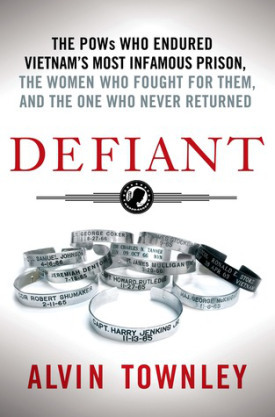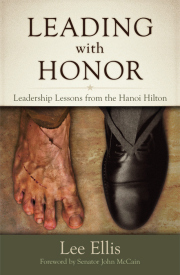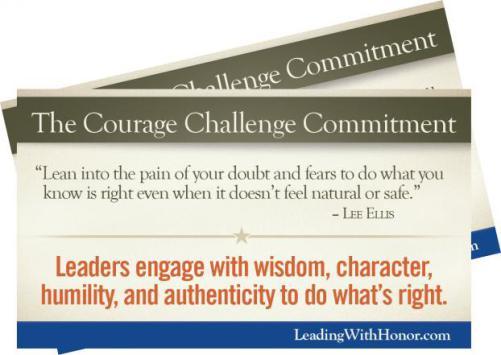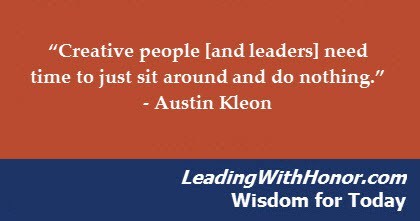Lee Ellis's Blog, page 287
December 23, 2015
Need some courage during the holidays? Free Emergency Download Enclosed
Need some courage during the holidays? How do you navigate through those challenging conversations the right way? Let the Courage Challenge Card help!
Download and Share!


December 21, 2015
New Film “Jeremiah” – A Must Watch for All Leaders
In this new original film, Jeremiah Denton, one of Lee Ellis’ senior leaders in the POW Camps, is featured as family, friends, and fellow POWs help tell the story of this American hero and leader who led the way for prisoners in Hanoi and returned from Vietnam to become a U.S. Senator from Alabama. Watch the entire film below, and be inspired –
Want to know more about Jeremiah Denton’s story (and his fellow POWs)?

During the Vietnam War, hundreds of American prisoners-of-war faced years of brutal conditions and horrific torture at the hands of North Vietnamese guards and interrogators who ruthlessly plied them for military intelligence and propaganda. Determined to maintain their Code of Conduct, the POWs developed a powerful underground resistance. To quash it, their captors singled out its eleven leaders, Vietnam’s own “dirty dozen,” and banished them to an isolated jail that would become known as Alcatraz. None would leave its solitary cells and interrogation rooms unscathed; one would never return.
A powerful story of survival and triumph, Alvin Townley’s Defiant will inspire anyone wondering how courage, faith, and brotherhood can endure even in the darkest of situations.
Winner of the Georgia Author of the Year Award in History


5 Quick, Smart Listening Tips for Leaders – A Musical Analogy
The leadership gift of listening requires sacrificial humility, courage, commitment, and lots of practice. Here are 5 quick, smart listening tips based on a musical analogy from colleague, Harry Glantz –
Multi-Task to Be a Good Listener. Good listening does take focus, but a good listener also has to multi-task.
Intonation—You Have to Play in Tune with each other.
Find the Rhythm. Listening is waiting for the right moment to contribute to the conversation.
Be Creative in Your Response. Listening closely allows you to be more creative and relevant in the conversation.
Practice Listening. Musicians practice for hours, and good listeners need practice too.
See the entire article on the Leading with Honor website this month!


December 20, 2015
On This Day in Leadership History, December 20, 2015
On this day in leadership history in 1946, the Frank Capra film “It’s A Wonderful Life” had a preview showing for charity at New York City’s Globe Theatre, a day before its “official” world premiere. James Stewart and Donna Reed star in the film. Almost 70 years later, this film’s legacy still has inspiration and influence for millions of people! May we all have that kind of legacy as leaders…
It’s a Wonderful Life – Wikipedia


December 19, 2015
How Does Your Team Celebrate? Some Fun Ideas Inside…
What does your work team do to celebrate a goal or achievement? We think teams need to be creative in how they celebrate? Maybe an end zone dance?? Here are some fun ideas…


December 18, 2015
Leading with Honor Wisdom for Today, December 18, 2015
December 17, 2015
Thanks Benjamin, for Your Leading with Honor Comments
 Thanks to Leading with Honor reader, Benjamin, for your enthusiastic comments –
Thanks to Leading with Honor reader, Benjamin, for your enthusiastic comments –
“Thank you very much Mr. Ellis, I am half way through your book right now and I am loving it. You have an enviable amount of resolve and are truly a man to look up to.”
Read more comments here.


December 16, 2015
The Link Between Values, Culture and Profits and Behavioral Team Analysis
(Editor’s Note: this month, we’re featuring this very insightful article from good friend and consultant, Stuart R. Levine. We’re grateful for his expertise on the topic of work culture and values.)
by Stuart R. Levine (Originally published in The Credit Union Times)
It has been shown that most organizations hire employees for the skills they possess, yet fire employees for poor behavior. Even worse is when poor behavior is tolerated to the point of lost productivity and the turnover of “good” employees. This hiring – firing cycle costs organizations millions of dollars a year in recruiting and training costs. Poor behavior is usually due to a mismatch in values and/or a failure of the employee to assimilate into the organization’s culture. But how do companies both large and small, ensure that new hires are a good cultural fit?
Culture is a widely used and misunderstood term. By the strictest definition, culture is the sum of attitudes, customs, and beliefs that distinguish one group of people from another. An organization’s culture can be defined as a company’s prevailing ideas, values, attitudes, and beliefs that guide the way in which its employees’ think, feel, and act.
Therefore, a company’s culture directly impacts the decisions and actions of the organization.
A positive culture, however, can obviously have the opposite effect. The Disney organization, for example, prides itself on closely following its six core values:
Integrity
Trust
Teamwork
Honesty
Play by the Rules
Respect
These values drive the Disney culture of excellence, resulting in a 54% increase in net profits over the last four fiscal quarters. Disney is not an anomaly. A 2014 study, “Parsing Organizational Culture: How the Norm for Adaptability Influences the Relationship Between Culture Consensus and Financial Performance in High-Technology Firms,” by Jennifer A. Chatman, David F. Caldwell, Charles A. O’Reilly and Bernadette Doerr, concluded that corporations with a strong positive culture performed better financially over a volatile three-year period than those companies with weaker cultures.
So how does a company as large and diverse as Disney consistently maintain an organizational culture so powerful? The answer is relatively simple, according to Disney. It’s all about the people.
The Walt Disney Company has consistently worked to attract, develop and retain employees dedicated to their vision and values.
This modest statement is profound in its simplicity. In order to hire employees to maintain the corporate values and fit into the culture, an organization must first know what their values and culture are. This is not as easy as a simple survey or scanning a company’s website to find its mission and values statement. If values and culture are not systematically and strategically created, they will evolve on their own, sometimes with devastating consequences, as in the case of the Enron scandal of 2001 in which Enron’s “get it done” culture that emphasized profits and gaming the system to look good to Wall Street investors, led to the company’s eventual bankruptcy, the largest in U.S. history and the dissolution of Arthur Andersen, one of the five largest audit and accounting firms in the world.
Leadership must profess the desired values and demonstrate them on a daily basis. They must become masters at strategic communication and consistently walk the talk.
A culture must be nurtured and supported and those not demonstrating the organizational values or not fitting into the culture cannot be allowed to stay.
It’s far easier to create a corporate culture than to change one. To change a culture, a company must reward those possessing the desired values, while purging those that do not. Like replacing cold water in a bath, new incoming employees that demonstrate the desired values should be embraced or “run into” the organization, while those current employees not exhibiting the corporate values are “let out” the drain. The key, however, is finding and hiring those candidates with the desired values.
Using structured or behavioral based interviews, proven effective by Disney, Google and Southwest Airlines, is paramount in good hiring practices.
In order for this to be successful, however, the organization must have a clearly defined set of values. Interview questions can then be constructed to elicit descriptions of previous behaviors exhibited in specific situations, thus exploring candidates’ individual values. Instead of a subjective interview question such as, “tell me what you value” or “what is your leadership style?” which tell you nothing about the candidate, questions such as, “tell me about a time when you were leading a team and one of your subordinates didn’t agree with your course of action” can elicit a much more descriptive response that can give you insight into your candidates value system.
When leadership establishes and nurtures a set of pristine values that creates a culture of excellence and hires those possessing these values, positive outcomes and financial success is inevitable. Please share your comments and experience in this post, too –
SL
Original Article Source – Link
Behavioral assessments like Leadership Behavior DNA can easily pinpoint natural strengths and struggles as a foundation for leadership evaluation and development. Click to learn more, and download a free report.


December 15, 2015
One Important Leadership Lesson Still Used 40 Years Later
In this quick clip, Lee shares an important lesson from the POW camps that he still uses today. This is inspiring, powerful advice if you’re being challenged right now to make steady progress everyday in life and work. Be encouraged today!


December 13, 2015
On This Day in Leadership History, December 13, 2015
On this day in leadership history in 1928, George Gershwin’s musical work “An American in Paris” was premiered by the New York Philharmonic Orchestra. An American composer and pianist, Gershwin is known worldwide for his well-known melodies. What’s the leadership lesson? Your passion must drive your success—misguided motivation will always leave you coming up short in your aspirations.
George Gershwin – Wikipedia













